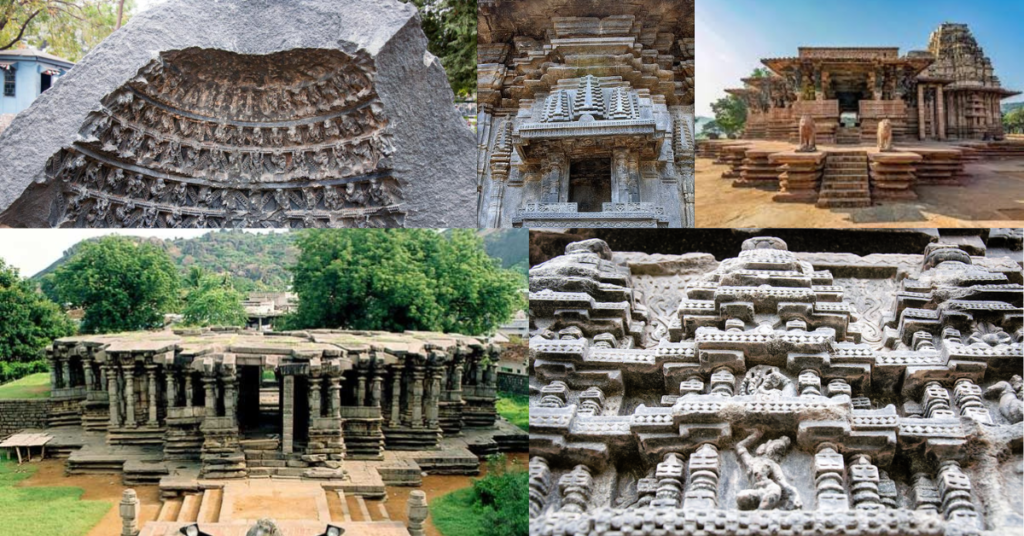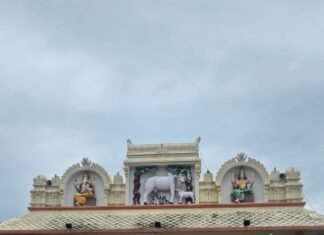Introduction Thousand Pillar Temple
A must-see location for devotees, history buffs, and lovers of architecture alike. The Thousand Pillar Temple is an exceptional example of architectural excellence from the Kakathiya period. This temple will leave you mesmerized by its structural beauty and intrigued by its historical significance.

Historical Background of Thousand Pillar Temple
The Thousand Pillar Temple, built in 1163 AD by King Rudra Deva of the Kakatiya dynasty, stands as a remarkable example of Kakatiya architecture. Dedicated to Lord Shiva, Vishnu, and Surya, it was constructed with a star-shaped layout and supported by intricately carved pillars. The temple earned its name from the multitude of these pillars, though it doesn’t have a thousand. During the 14th century, the temple was severely damaged by the Tughlaq dynasty’s invasion. Despite the destruction, restoration efforts continue to preserve its architectural and cultural significance.
Also Read: Medaram Jathara South Asia’s Largest Tribal Festival
Architecture of Thousand Pillar Temple
The Thousand Pillar Temple, a shining example of Kakatiya architecture, reflects the dynasty’s advanced engineering and artistic capabilities. The temple, which was constructed in 1163 A.D., is a remarkable building that combines Dravidian and Chalukyan architectural elements. Here is an in-depth look at the various architectural aspects of the Thousand Pillar Temple:
Star-Shaped Layout

A defining element of Kakatiya architecture, the temple has a star-shaped (stellate) pattern. This design adds an element of geometric complexity and visual appeal to the structure. The star-shaped platform elevates the temple by about one meter from the ground, providing it with a commanding presence and a grand approach.
The Thousand Pillars

Contrary to its name, the temple does not have a thousand pillars, but it does feature a large number of intricately carved pillars. These pillars are arranged in such a way that they create a labyrinthine effect, enhancing the temple’s architectural complexity. Exhibiting the skill of the Kakatiya artisans, each pillar is embellished with complex designs of geometrical shapes, floral patterns, and mythological characters
Trikutalayam (Three Shrines)
The temple is a “Trikutalayam,” meaning it houses three shrines dedicated to three different deities:
- Lord Shiva (Rudreshwara): who is symbolized by a gorgeously carved lingam, is the subject of the main and primary temple.
- Lord Vishnu: Lord Vishnu is honored in one of the other shrines, demonstrating the period’s religious
- Lord Surya (Sun God): The third shrine is devoted to Lord Surya, the sun god, demonstrating the significance of the sun god in Hinduism.
The “Mukha Mandapa,” a shared corridor held up by elaborately carved pillars, connects these three sanctums.
Mukha Mandapa (Main Hall)

The Mukha Mandapa serves as the main hall connecting the three shrines. This hall is supported by a multitude of pillars, each decorated with elaborate carvings that depict scenes from Hindu mythology, various deities, and intricate floral motifs. The hall is spacious and well-ventilated, allowing light to filter through and illuminate the carvings, enhancing their beauty.
The Nandi Mandapa

In front of the main sanctum dedicated to Lord Shiva is the Nandi Mandapa, housing a large monolithic statue of Nandi, the bull. To represent the Shiva lingam‘s function as Lord Shiva’s celestial vehicle, the Nandi statue is placed facing it. The statue is intricately carved and polished, reflecting the high level of craftsmanship of the Kakatiya artisans.
Sculptural Brilliance
The Thousand Pillar Temple Warangal is renowned for its exquisite sculptures, which are a blend of Dravidian and Chalukyan stylesThe temple’s outside walls are decorated with elaborate floral designs, numerous deities, and images from Hindu mythology carved in great detail. The sculptures also include beautifully carved statues of elephants and other creatures, enhancing the magnificence of the temple.
Also Read: Discover the Rich Biodiversity of Kakatiya Zoological Park
The Raised Platform
The temple is built on a raised platform that elevates it by about one meter from the ground. This elevated platform not only provides a majestic appearance but also serves a practical purpose by protecting the temple from potential flooding and other environmental factors.
Intricate Carvings and Decorations

The temple is completely decorated with elaborate embellishments and carvings. The pillars, walls, ceilings, and even the floors feature detailed artwork that includes depictions of gods and goddesses, mythological scenes, and intricate floral and geometric patterns. These carvings are not only artistic masterpieces but also serve to tell stories and convey religious and cultural messages.
Architectural Balance

Despite the complexity and intricacy of its design, the Thousand Pillar Temple maintains a sense of architectural harmony. The various elements, including the star-shaped layout, the multitude of pillars, the three sanctums, and the detailed sculptures, come together to create a cohesive and balanced structure. This harmony reflects the advanced engineering and architectural knowledge of the Kakatiya dynasty.
Destruction of the Thousand Pillar Temple
The Thousand Pillar Temple, originally a magnificent structure, faced significant damage over the centuries. Its destruction can be attributed to a series of events, particularly during the period of the Tughlaq dynasty’s invasion.

Invasion and Damage
In the early 14th century, the Tughlaq dynasty, which ruled parts of South India, invaded the region where the Thousand Pillar Temple was located. The temple suffered great damage during their attack.. The Tughlaqs were known for their military campaigns and conquests, and their invasions often led to the destruction of many cultural and religious sites.
Also Read: Experience the Spiritual Majesty of Bhadrakali Temple in Warangal
Causes of Destruction
The destruction of the Thousand Pillar Temple was primarily due to the following reasons:
- Military Conquest: The temple was caught in the turmoil of military conquests and was subjected to vandalism and structural damage.
- Religious Conflicts: The Tughlaq dynasty, which was of Islamic faith, might have targeted Hindu temples as part of their efforts to assert dominance and suppress local religious practices.
- Neglect and Wear: Over time, the damaged temple also suffered from neglect and natural wear and tear, which contributed to its deterioration.
Restoration Efforts
Despite the significant damage, efforts have been made to restore the Thousand Pillar Temple to its former glory. The temple has been maintained and repaired by the Archaeological Survey of India (ASI) and other cultural conservation organizations. Restoration activities have included cleaning the sculptures, reinforcing the pillars, and maintaining the temple complex to ensure its preservation for future generations.
Cultural and Religious Significance
The Thousand Pillar Temple is not only an architectural marvel but also a significant cultural and religious site. It attracts devotees, historians, and tourists from all over the world. The temple is a hub of various religious activities and festivals, with Maha Shivaratri being one of the most celebrated events. During this festival, the temple complex is adorned with lights, and a large number of devotees gather to offer prayers and participate in rituals.
Additional Information
How to Reach
The Thousand Pillar Temple is easily accessible by road, rail, and air. The nearest city is Warangal, which is well-connected to major cities like Hyderabad, Chennai, and Bangalore. From Warangal, visitors can hire a taxi or use public transport to reach the temple, which is about 6 kilometers from the city center.
Timings and Entry Fee
The temple is open to visitors every day from 6:00 AM to 8:00 PM. There is no entry fee to visit the temple, making it an accessible destination for everyone.
Best Time to Visit
The ideal time to visit the Thousand Pillar Temple is during the winter months, from October to February when the weather is pleasant and conducive for sightseeing. Visiting Maha Shivaratri offers a unique experience due to the festive atmosphere and special rituals performed at the temple.
Also Read: Ultimate Guide to Laknavaram Lake: Nature’s Hidden Gem
Conclusion
The Thousand Pillar Temple stands as a glorious representation of the Kakatiya dynasty’s architectural ingenuity and cultural heritage. Its intricate carvings, unique layout, and historical significance make it a must-visit destination for anyone interested in India’s rich history and architectural marvels. A visit to this temple offers a glimpse into the artistic brilliance and spiritual depth of the Kakatiya period, leaving visitors in awe of its timeless beauty.
Frequently Asked Questions(FAQS)
A: The Thousand Pillar Temple is an architectural marvel from the Kakatiya period, built in 1163 AD in Warangal.
A: The temple was constructed by King Rudra Deva of the Kakatiya dynasty.
A: The temple is dedicated to Lord Shiva, Lord Vishnu, and Lord Surya.
A: The Nandi Mandapa houses a large monolithic statue of Nandi, the bull, facing the main sanctum dedicated to Lord Shiva.
A: The best time to visit is during the winter months from October to February.











